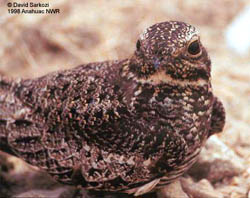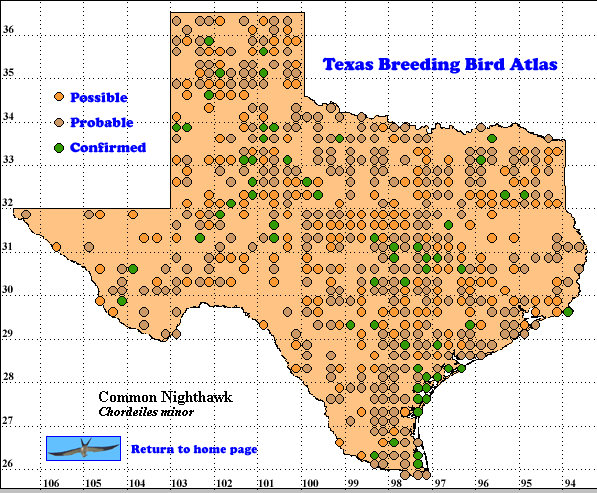Chordeiles minor
The Common Nighthawk is the most widespread and well-known member of the goatsucker family in Texas. Its nasal peent calls and erratic bouncing flight make it recognizable to most people. It is often known as the ‘bullbat’ for the sound made during the courtship flight of the male as he turns abruptly out of a steep dive. The air rushing through his wings makes a booming noise that resembles the bellowing of a bull. This nighthawk breeds from Canada south to Panama and winters in South America (Poulin et al. 1996).
The Common Nighthawk migrates throughout Texas, making the determination of breeding status more difficult. Oberholser (1974) states that nighthawks migrate from early April to late May with an extreme late date of 17 June. Additionally, they may migrate in groups of up to 1,000 individuals (Poulin et al. 1996), so the presence of multiple individuals or a pair during the period of migration may be misleading to an atlaser as to the birds’ breeding status.
DISTRIBUTION: The Common Nighthawk can be found throughout the state of Texas where it is usually associated with open country, open fields, and urban areas with flat rooftops suitable for nesting. Along the Rio Grande River from Terrell County(29102) to Starr County (26098), it appears to be replaced by the Lesser Nighthawk (Chordeiles acutipennis), which may exclude the Common Nighthawk from areas of suitable habitat (Caccamise 1974).
SEASONAL OCCURRENCE: With its distinctive flight behavior and diurnal and crepuscular habits, the Common Nighthawk is an easy bird to identify and to assign either possible or probable breeding status. However, it is a difficult bird to confirm, with only 6% of the records representing confirmation (67 out of 1037 total records). Most of those confirmed records were for nests with eggs or for fledged young.
This species has a long breeding season, with egg dates reported from 28 March to 29 July (Oberholser 1974). TBBAP data document a later egg date of 9 August from a nest with eggs found in latilong 33101, quad A2. Double-brooding has not been reported for Texas, but it has been documented in other parts of their range (Weller 1958). Thus, this late egg date may represent a second clutch.
BREEDING HABITAT: The Common Nighthawk nests in open areas unobstructed by trees or tall shrubs. It will not nest in the seclusion of a forest. Secondarily, it chooses nesting areas in association with trees and vegetation for roosting and for the production of the flying insects it consumes (Wedgwood 1973). The open areas used for nesting include gravel beaches, native grasslands, burned areas, cultivated fields with some barren patches, disturbed areas within a forest, extensively logged areas, and even between railroad tracks (Bent 1940, Poulin et al. 1996). In urban areas, it nests on flat gravel roofs but will avoid aluminum roofs. In some areas of its range, it apparently prefers natural sites even though gravel roofs are available (Brigham 1989).
The Common Nighthawk lays its two eggs on bare ground, rock, gravel, sand, wood chips, fallen leaves, needles, or occasionally on living vegetation (Poulin et al. 1996). At times it will nest on stumps or atop fence posts. The eggs may be laid in a slight depression, but no materials are added to the nest (Bent 1940).
STATUS: The Common Nighthawk is on the Blue List (Tate 1986) and appears to be declining in Texas. Breeding Bird Survey data (Sauer et al. 1995) show a slight, but not statistically significant, decline since 1966; however, since 1980 it has declined significantly in Texas. The rate of decline is higher than the average for the United States and Canada, but not as great as in other parts of its range. Possible reasons for the declines include non-selective pesticide use for mosquito control and a change from gravel roofs to smooth roofs (Poulin et al. 1996). Local checklists support the decline seen in BBS data. For example, in Smith County (32095), the Common Nighthawk’s status changes from uncommon in summer in 1962 to rare by 1988 (Tyler Audubon Society 1962, Smith 1988). By 1994 it is not listed as a summer bird in Tyler State Park (Smith 1994).
Although the nighthawk may be declining in numbers, it appears to be more widespread in east Texas than was previously thought. Oberholser (1974) lists the species as uncommon in the northeast (north of Huntsville and east of Dallas) and does not show any breeding records for that part of the state. The Texas Ornithological Society (1995) lists the nighthawk as a summer resident except in the forested areas of east Texas. TBBAP data show the Common Nighthawk to occur throughout that part of Texas, although the data should be viewed somewhat cautiously. With their migration in Texas lasting from early April to late May (Oberholser 1974), more than half of the records (55%) from northeast Texas represent possible migrants. However, nighthawks were confirmed breeding in the area with five records of the presence of fledged young. The difference between TBBAP records and previous knowledge of the bird in northeast Texas may be a result of urban sprawl. Nighthawks require open areas and have readily adapted to towns and cities. As the forests have been opened up for urban development, nighthawks may have taken advantage of the resulting open areas.
Text by Cade L. Coldren (ca. 1997)
Literature Cited
Bent, A. C. 1940. Life histories of North American cuckoos, goatsuckers, hummingbirds, and their allies. U.S. Nat. Mus. Bull. No. 176.
Brigham, R. M. 1989. Roost and nest sites of Common Nighthawks: Are gravel roofs important? Condor 91: 722-724.
Caccamise, D. F. 1974. Competitive relationships of the Common and Lesser Nighthawks. Condor 76: 1-20.
Oberholser, H. C. 1974. The bird life of Texas. University of Texas Press, Austin.
Poulin, R. G., S.D. Grindal, and R.M. Brigham. 1996. Common Nighthawk, Chordeiles minor. In The Birds of North America, No. 213. (A. Poole and F. Gill, eds.) The Academy of Natural Sciences, Philadelphia, and The American Ornithologists’ Union, Washington, D.C.
Sauer, J. R., B.G. Peterjohn, S. Schwartz, and J.E. Hines. 1995. The North American Breeding Bird Survey Home Page. Version 95.1. Patuxent Wildlife Research Center, Laurel, MD. Smith, G., compiler. 1988. Field check-list: Birds of Smith County, Texas. Tyler Audubon Society, Tyler.
Smith, G., compiler. 1994. Birds of Tyler State Park: A field checklist. Texas Parks and Wildlife Department, Natural Resources Program, Austin.
Tate, J., Jr. 1986. The blue list for 1986. Am. Birds 40:227-236.
Texas Ornithological Society. 1995. Checklist of the birds of Texas, 3rd ed. Capital Printing, Inc., Austin.
Tyler Audubon Society. 1962. Field Check-list: Birds of Smith County, Texas. Tyler Audubon Society, Tyler.
Wedgwood, J.A. 1973. Nighthawks in the city. Blue Jay 31:82-88.
Weller, M.W. 1958. Observations of the incubation behavior of a Common Nighthawk. Auk 75:48-59.

